Valero: A High Dividend, for a Price
Looking for exposure to the oil and gas sector without undue risk? Valero Energy Corporation (NYSE:VLO) might be one possibility, in my view. While the company operates in a volatile industry, it has consistently increased its dividend and reduced its shares outstanding throughout its history.
The stock has a place on the High-Yield Dividend Screener & High-Dividend Yield Stocks in Gurus' Portfolios, meaning it is a guru holding that provides a dividend yield of at least 4%. GuruFocus gives the company a financial strength rating of 6 out of 10, a profitability rating of 6 out of 10 and a valuation rating of 4 out of 10.
The company describes itself in its Q1-2020 earnings release as being, "an international manufacturer and marketer of transportation fuels and petrochemical products." It belongs to the Fortune 500 and operates 15 petroleum refineries and 14 ethanol plants, which are located in the United States, Canada and the United Kingdom. In addition, it has a joint venture partner in Diamond Green Diesel, which operates "North America's largest biomass-based diesel plant."
Between mid-June 2010 and November 2019, the share price rose from around $16 to $100, but in early 2020, as demand for oil and gas collapsed, the stock price dipped sharply before making a modest recovery:
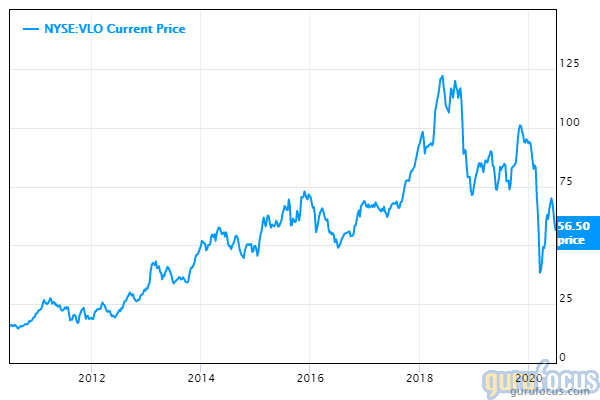
Valero makes its money by margin and volume. In its 10-K for 2019, the company explained the margin factor as follows:
"Our financial results are primarily affected by the relationship, or margin, between refined petroleum product prices and the prices for crude oil and other feedstocks. Historically, refining margins have been volatile, and we believe they will continue to be volatile in the future."
The company must buy all its feedstock since it is not a producer, and it must buy it well in advance of the time it goes out as a refined product. When oil prices change, the company bears a risk over which it has no control. For example, it may buy feedstock when prices are high and sell when prices are low. In addition, there are other variable risks, including environmental regulations and interest rates.
Still, Valero's diluted earnings per share have remained within a fairly tight range since 2012:
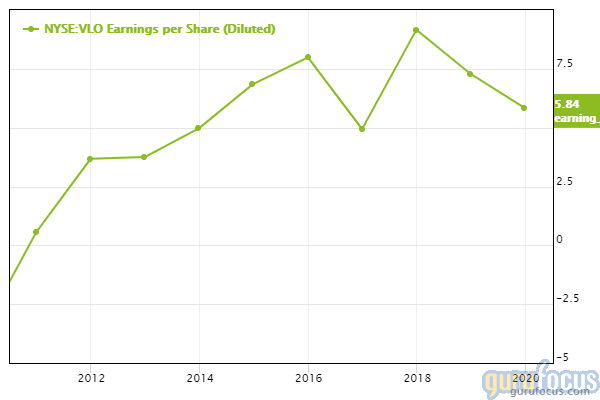
Additionally, its dividends per share have grown consistently over the past decade:
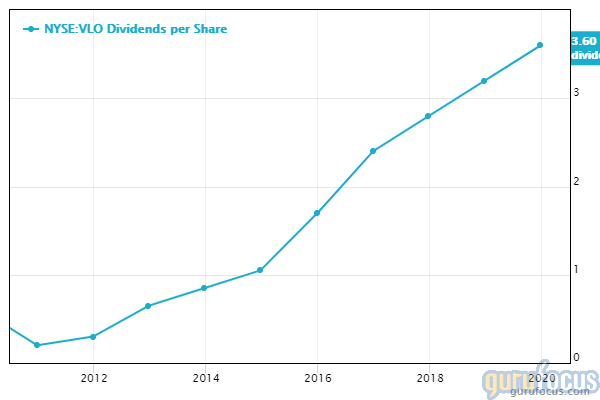
To analyze the Valero dividend more thoroughly, we will review each line in the GuruFocus Dividend & Buy Back table:

The current yield is 6.61%, and as the below 10-year chart of dividend payments and the share price shows, the yield is not based on a declining share price. Rather, the dividend level is based on the policies set by the Valero board. To consistently raise the dividend this way suggests the company has ample free cash flow.
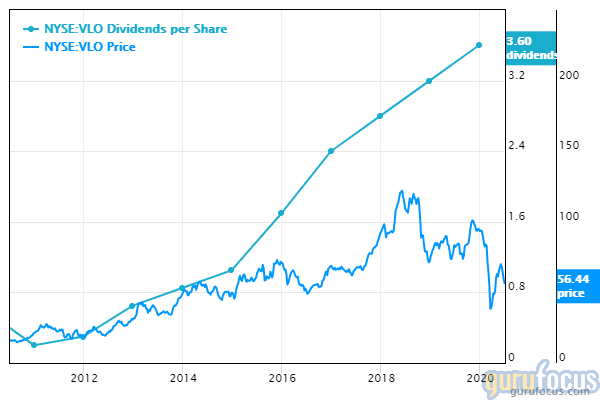
The dividend payout ratio figure tells us what proportion of the company's earnings are being used to pay dividends. The ratio is currently at 38.3%, meaning the company has slightly more than 60% to reinvest in itself for future growth.
In reporting its Q1 2020 results, the company reported it targets a payout ratio (for both dividends and buybacks) in a range of 40% to 50%.
The table shows an average annual dividend growth rate of 14.5% over the past three years. That's quite rapid, and according to the 10-K data from the previous three years, the company saw the following more precise increases:
2016-17: $0.40 increase, from $2.40 to $2.80 (16.67%)
2017-18: $0.40 increase, from $2.80 to $3.20 (14.23%)
2018-19: $0.40 increase, from $3.20 to $3.60 (12.50%)
In the first-quarter 2020 earnings release, Valero announced it had paid a quarterly dividend of $0.98. That works out to an annual dividend of $3.92, or an increase of $0.32, down from the previous increases of $0.40 each.
The forward dividend yield of 6.87% is higher than the TTM (trailing twelve-months) yield of 6.61%.
The five-year yield on cost comes in at a suspiciously high 21.41%. This metric refers to the average annual return an investor would receive if they bought the stock and held it for five years while the company continued to grow the dividend at the same rate as it had in the previous five years.
The reason it is high is because of the high growth rate in the past three years. Double-digit increases in the dividend will lead to a high yield-on-cost when extrapolated over the next five years.
But, as we know, this year's increase (assuming it continues at $0.98 per quarter) will be smaller than those of previous years. A $0.32 increase will produce a growth rate of 8.89% in 2020, and five years at that rate will generate a significantly lower yield-on-cost.
The share buyback ratio is currently 3.1, which means the company has been repurchasing its shares. If we look at the number of shares outstanding over the past 10 years, we see a consistent downward trend:
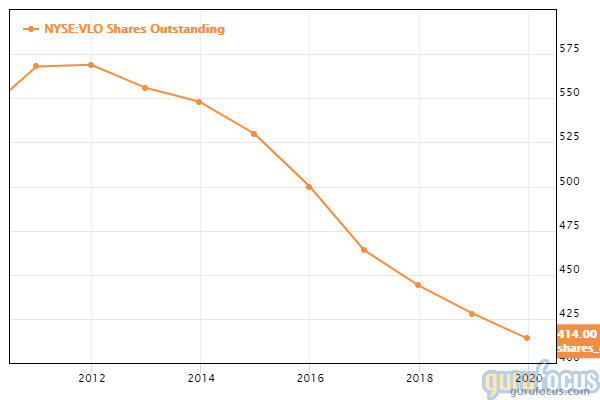
In terms of guru ownership, 13 gurus own shares in Valero. Barrow, Hanley, Mewhinney & Strauss had the largest position at the end of the first quarter with 3,892,784 shares representing 0.73% of the company's stock. Pioneer Investments (Trades, Portfolio) was the second-largest holder at nearly 3 million shares and Joel Greenblatt (Trades, Portfolio) at Gotham Asset Management held 284,705 shares.
Since the beginning of this year, more gurus have been selling than buying:
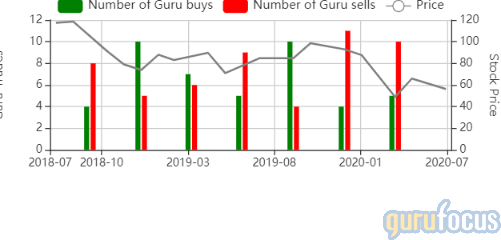
Valuation
The refiner receives a low rating of 4 out of 10 for valuation, suggesting it is no bargain. That's partially confirmed with a check of its price-earnings ratio, which stands at 57.01. Over the past 10 years, the price-earnings ratio has ranged from a low of 5.08 to a high of 75.39, while the median was 10.07.
Unfortunately, Valero's business predictability rating is only 1 out of 5 stars, so we cannot take any direction from the discounted cash flow (DCF) model. The PEG (price divided by earnings growth) ratio is also meaningless at 148.5.
Conclusion
Valero Energy operates in a cyclical and unstable industry, but management has done an excellent job of taking care of shareholders. It has used its free cash flow to reduce the number of shares, which increases earnings per share, making more available for dividends and dividend increases while still maintaining a prudent payout ratio.
With a high dividend that seems sustainable, I thilnk Valero is worth the attention of income investors who are willing to pay handsomely for the stock, but it may not be so good as a value opportunity.
Disclosure: I do not own shares in any companies named in this article and do not expect to buy any in the next 72 hours.
Read more here:
Wells Fargo Faces a Forced Dividend Cut
AIG: Despite the Pandemic, There's Reason for Optimism
Taiwan Semiconductor: A High-Tech Stock With a Promising Dividend Base
Not a Premium Member of GuruFocus? Sign up for a free 7-day trial here.
This article first appeared on GuruFocus.

 Yahoo Finanza
Yahoo Finanza 